Papers by Prof. Kanij Fatema
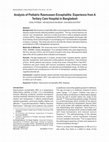
Bangladesh Journal of Child Health
Background: Rasmussens encephalitis (RE) is rare progressive cerebral inflammatory disease predom... more Background: Rasmussens encephalitis (RE) is rare progressive cerebral inflammatory disease predominantly affecting pediatric population. The key clinical features are seizure and hemiparesis. Seizure is mostly focal with or without epileptia partialis continua (EPC). Diagnosis is established by EEG showing epileptic discharges with focal slowing, focal cortical atrophy in neuroimaging and T cell dominated encephalitis in biopsy or autopsy. This study was done to describe the clinical, laboratory features and treatment of RE in Bangladesh perspective. Materials & Methods: This study was done in Department of Pediatric Neurology, IPNA, BSMMU, Dhaka, Bangladesh. Four admitted children who were diagnosed as RE from January 2016 to July 2019 were included in this study. Retrospective detail data of the all four patients were collected and analyzed. Results: The age ranging was 3-12 years, all were male. Cognitive decline, speech disorder, hemiparesis were observed in all the patients. Am...
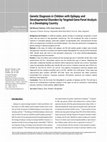
Journal of Epilepsy Research
Background and Purpose: In childhood epilepsy, genetic etiology is increasingly recognized in rec... more Background and Purpose: In childhood epilepsy, genetic etiology is increasingly recognized in recent years with the advent of next generation sequencing. This has broadened the scope of precision medicine in intractable epilepsy, particularly epileptic encephalopathy (EE). Developmental disorder (DD) is an integral part of childhood uncontrolled epilepsy. This study was performed to investigate the genetic etiology of childhood epilepsy and DD.Methods: In this study, 40 children with epilepsy and DD with positive genetic mutation were included retrospectively. It was done in a tertiary care referral hospital of Bangladesh from January 2019 to December 2020. Genetic study was done by next generation sequencing. In all cases electroencephalography, neuroimaging was done and reviewed.Results: In total, 40 children were enrolled and the average age was 41.4±35.850 months with a male predominance (67.5%). Generalized seizure was the predominant type of seizure. Regarding the association,...
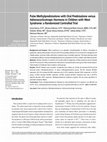
Journal of Epilepsy Research, 2021
Background and Purpose: West syndrome is an epileptic encephalopathy of infancy. According to gui... more Background and Purpose: West syndrome is an epileptic encephalopathy of infancy. According to guidelines, adrenocorticotrophic hormone (ACTH) is probably effective for the short-term management of infantile spasm, but there is little uniformity in treatment due to variable response. This study has been done to evaluate the efficacy of pulse methylprednisolone as compared to ACTH in children with West syndrome.Methods: Children between 3 months to 24 months with the diagnosis of West syndrome were included and ACTH and pulse methyl prednisolone followed by oral prednisolone were given after randomization. Total duration of treatment was 6 weeks in both groups.Results: Total 87 children were enrolled; 12 patients lost in follow up. Finally, 43 received ACTH and 32 received pulse methylprednisolone. In pulse methylprednisolone group, 28.13% showed 50-80% response, 28.13% showed 80-99% response and 21.87% patients showed 100% response. In ACTH group, 41.86% showed 50-80% response, 25.58...
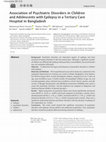
International Journal of Epilepsy, 2021
Background Psychiatric disorders are important aspects of epilepsy and have received increasing a... more Background Psychiatric disorders are important aspects of epilepsy and have received increasing attention in the last several years. Although a significant number of children are afflicted with epilepsy with psychiatric comorbidities, the actual burden was not evaluated sufficiently. Objective To determine the types and frequency of psychiatric disorders in children with epilepsy. Materials and Methods This hospital-based case-control study was conducted at the outpatient department of a tertiary care center in Dhaka, Bangladesh, from September 2018 to August 2019. In total, 68 epileptic children, ranging from 5 to 17 years of age, were enrolled as cases. A similar number of nonepileptic children of age, sex, and sociodemographic status matched were enrolled as control. Parent, teacher, and self-version of Bengali Development and Well-Being Assessment (DAWBA) were used to assess the psychiatric disorders, and the diagnosis was assigned as Diagnostic and Statistical Manual (DSM)-V of...
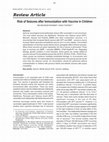
Bangladesh Journal of Child Health, 2020
Adverse neurological event particularly seizure after vaccination is not uncommon. The most linke... more Adverse neurological event particularly seizure after vaccination is not uncommon. The most linked vaccines are Diphtheria, Pertussis and Tetanus toxoid (DPT), Measles, Mumps and Rubella (MMR) and other combination vaccines. It is documented that increased febrile seizure after DPT and MMR vaccine is due to increase febrile episodes precipitating seizure and it is time related. Concomitant administration of vaccines cause seizure due to synergistic effect of those vaccines. When these vaccines are given separately, the risk of seizure is decreased. These type of vaccines are MMR + varicella (MMRV), DTaP-HepB-IPV etc. Regarding etiology, genetic mutation is most important. Some genes are closely related to vaccine induced FS and afebrile seizure like SCN1A, SCN2A, IFI44L, PCDH19 etc. Other causes are endotoxin mediated endothelial damage, IL-1â production and non CNS infection. It is well evident that consequences of not giving vaccine are far more than the adverse events. So Vaccina...
Bangladesh Journal of Child Health, 2021
Cockayne syndrome (CS) is a genetic disorder characterized by growth failure, microcephaly, cogni... more Cockayne syndrome (CS) is a genetic disorder characterized by growth failure, microcephaly, cognitive delay, visual and hearing disorders. Patients usually present with dysmorphism and global delay. It is an autosomal recessive disorder, mutation of two genes ERCC8 and ERCC6 were observed. We report a 4 year old child who was diagnosed as a case of Cockayne syndrome, based on clinical, neuroimaging and genetic study findings. This case had growth failure, dysmorphism, optic atrophy, global developmental delay, intracerebral calcification and mutation of ERCC8 gene.
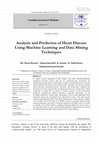
Canadian Journal of Medicine, 2021
In clinical, sciences expectation of heart malady is one of the foremost troublesome undertakings... more In clinical, sciences expectation of heart malady is one of the foremost troublesome undertakings. Nowadays, coronary illness may be a significant reason for bleakness and mortality in present-day society. Coronary illness could be a term that doles intent on countless ailments identified with the heart. Clinical determination is incredibly a big, however entangled errand that must be performed precisely, effectively, and unequivocally. Although huge advancement has been imagined within the finding and treatment of coronary illness, further examination is required. The accessibility of enormous measures of clinical information prompts the requirement for amazing information examination instruments to get rid of valuable information. Coronary illness determination is one in all the applications where information mining and AI instruments have demonstrated victories. This study used the machine learning algorithms KNN, Naïve Bayes, Random forest, Logistic regression, Support vector machine, J48, and Decision tree by WEKA software to spot which method provides maximum performance and accuracy. Using these algorithms with WEKA software, we made an ensemble (Vote) hybrid model by combining individual methods. Our research aims to access the effectiveness of various machine learning algorithms to diagnose the center disease and find the feasible algorithm, which is that the best for a heart condition.
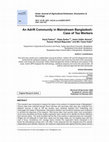
Asian Journal of Agricultural Extension, Economics & Sociology, 2021
This research was conducted to analyze the status of tea workers of selected areas of Bangladesh.... more This research was conducted to analyze the status of tea workers of selected areas of Bangladesh. Primary data were collected through direct interview and secondary data were also collected from different sources. A total of 100 tea workers were randomly selected from Ootterbhag and Indanugger tea estate of Moulvibazar. Descriptive statistics and functional analyses were employed to achieve the objectives of the research. Risk facing index, food security index, food consumption score were calculated and binary logistic regression were carried out to identify the factors affecting food security status. The study revealed that the life of tea workers in selected areas are vulnerable. Wages are not adequate to meet basic needs and the wage raises are not keeping pace with the cost of living. Considering 4.51 average family member the respondent family household is far below the international poverty line (1.90 US$). It was observed from the analysis that 52% sample respondents were ill...
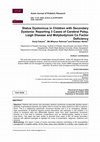
Asian Journal of Pediatric Research, 2020
Objective: Patients with primary and secondary dystonic syndromes occasionally develop severe epi... more Objective: Patients with primary and secondary dystonic syndromes occasionally develop severe episodes of generalized dystonia and rigidity which is known as status dystonicus (SD) or dystonic storm. This is a frightening hyperkinetic movement disorder and it is an emergency. Marked, rapid exacerbation of dystonia requires prompt intervention and admission in the hospital. It is critical to recognize early and differentiate dystonic storm from other hyperkinetic movement disorder as it may lead to metabolic complications such as rhabdomyolysis, leading to acute renal failure. This paper has been written to describe three cases of SD, all having secondary dystonia with different etiologies to highlight the mode of presentation, diagnosis, treatment and outcome. Methodology: We report 3 cases of severe secondary dystonia culminating in SD necessitating management in hospital setting. All the three cases were admitted in a tertiary care hospital and evaluated....
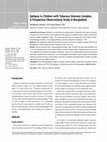
Journal of Epilepsy Research, 2020
Epilepsy is an important neurologic feature of patients with tuberous sclerosis complex (TSC). Mo... more Epilepsy is an important neurologic feature of patients with tuberous sclerosis complex (TSC). Most common seizure types are focal seizure and epileptic spasm. Seizure control often requires multiple antiepileptic drugs. This study has been done to evaluate the seizure types, electroencephalography (EEG), neuroimaging features, and drug treatment of epilepsy in TSC. Methods: This prospective observational study has been conducted on epilepsy patients with TSC at Bangabandhu Sheikh Mujib Medical University from 2011 to 2019. Results: Seventy patients with a mean±standard deviation age of 5.64±3.96 years were identified and 57.1% were female. Most common type of seizure was focal seizure (46%). Epileptic spasm occurred in 17% of patients and all of them had seizure onset before 1 year. In 47% of patients EEG showed focal epileptic discharge; hypsarrhythmia was found in most of the patients with epileptic spasm. Majority of the patients needed more than one drug to control seizure. Only 34% of patients were seizure free for at least 12 months and 22.8% had drug resistant epilepsy. Conclusions: This study highlights the pattern of seizure, treatment pattern, response to drug, and short-time outcome of children with TSC with epilepsy in a developing country like Bangladesh.
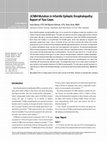
Journal of Epilepsy Research, 2020
Early infantile epileptic encephalopathy type 13 is a severe form of epilepsy caused by mutations... more Early infantile epileptic encephalopathy type 13 is a severe form of epilepsy caused by mutations in the sodium channel 8 alpha (SCN8A) gene. This gene encodes the neuronal voltage-gated sodium channel which plays vital role in neuronal excitability. Here we present two cases with SCN8A encephalopathy. Both cases had mutation in p.Arg1872Gin the SCN8A gene, which was detected by targeted next generation sequencing. Case 1 was a 14-month old boy, who had a normal birth history with normal development up to 6 months and then developed repeated generalized seizure, which was nonresponsive to multiple antiepileptic drugs. He also had neuroregression and dystonia. His electroencephalogram (EEG) showed progressive background abnormality with burst suppression pattern. His metabolic panel was normal and had partial response to carbamazepine. The second case was for an 11-month old boy with the onset of seizure at the age of 7 months. Seizure was generalized, resistant to multiple antiepileptic drugs. He had developmental delay from beginning, no movement disorder. EEG showed focal discharge from left temporal and occipital region. He showed partial response to oxcarbazepine. Our cases had similarities with the previously reported cases. The detailed discussion of our cases would contribute to early detection and targeted treatment of SCN8A encephalopathy. This also gives special emphasis on a genetic test in infants with intractable epilepsy, movement disorder and developmental delay.
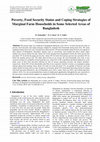
Asian Journal of Agricultural Extension, Economics & Sociology, 2017
The present study was conducted in Bangladesh during the years 2012-13 to know the present status... more The present study was conducted in Bangladesh during the years 2012-13 to know the present status of poverty, food insecurity and coping strategies adopted by marginal farm households during food crisis. The study employed mainly farm level cross sectional data collected from 150 farm households taking 50 from each upazila of three districts of Bangladesh. Descriptive statistics such as cost-of-basic need method and direct calorie intake method were used to analyze the data. About 24% of the marginal farm households lie below the lower poverty line and about 37% lie below the upper poverty line. About 19% lie below the hardcore poverty line and about 35% lie below the absolute poverty line. The study observed that on an average, the rural households were more or less secured in relation to availability of food round the year. About 62% of the respondents identified landlessness as the prime cause of their food insecurity followed by lack of income generating activities and natural calamities, respectively. About 49% of farm households relied like on less expensive food for everyday as consumption coping strategy during food shortage where about 22% took less food and about 17% cut quantity of food per meal and reduce number of meals eaten in a day. Irrespective of location, about 53% reliant upon borrowing money for coping with food insecurity followed by sale of households assets (45%), reduce food cost (40%) and seeking help from relatives (36%). It is also recommended that creation of employment opportunities throughout the year, especially in the lean season, and government supports are suggested to tackle the food insecurity problems for the study areas.
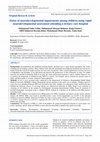
International Journal of Contemporary Pediatrics, 2019
Background: Developmental and childhood neuropsychiatric disorders have a large burden throughout... more Background: Developmental and childhood neuropsychiatric disorders have a large burden throughout the world, including the developing countries. Many children with clinically identifiable developmental problems present late for medical help due to lack of simple measures for their early recognition. These missed opportunities increase the level of dependence and disability of an individual and decrease the productivity of the community at large. So simple measures are needed to determine NDIs at an early age where professional expertise is sparse. Authors objective was to estimate the proportion of children having NDIs in a tertiary care hospital, and to estimate the specific types of NDIs, and their grades of severity, within the study population.Methods: It was a cross sectional study conducted at the Department of Pediatrics, Bangabandhu Sheikh Mujib Medical University (BSMMU), Dhaka, Bangladesh and the duration of the study was six months. Children aged 0-2 years who were attend...
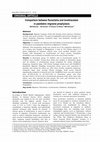
Bangladesh Medical Journal Khulna, 2019
Background: Migraine hampers child's life through school absence, limitation of home and soci... more Background: Migraine hampers child's life through school absence, limitation of home and social activities. The goal of prophylactic (preventive) therapy is to reduce headache frequency, headache days, and headache severity with minimum side effects. Objective: To evaluate the efficacy and tolerability of levetiracetam compared to flunarizine as prophylactic treatment of Migraine in children. Methods: This prospective study was carried out in the outpatient department of a tertiary care hospital in Bangladesh. A total of 105 children aged 6-15 years, diagnosed as migraine without aura, were enrolled. Patients were treated with flunarizine or levetiracetam for three months. Headache disabilities were evaluated at baseline and at the end of three months. Results: In flunarizine group, 54 children and in levetiracetam group, 51 children were enrolled. Among them thirty nine children in flunarizine group and 36 children in levetiracetam group completed the study. Headache frequency,...
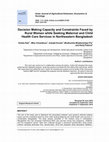
Asian Journal of Agricultural Extension, Economics & Sociology, 2019
The aim of the study was to determine the association between rural women’s decision-making power... more The aim of the study was to determine the association between rural women’s decision-making power and the constraints faced by them while seeking Maternal and Child Health care services in northeastern Bangladesh. The study sample consisted of 150 mothers living in northeastern Bangladesh who had accessed institutional MCH care services during their pregnancy, childbirth and the postpartum period. Data were collected through a structured questionnaire using simple random sampling technique from January-April, 2018 and analyzed using descriptive statistics, decision making index and constraints facing indexing method through SPSS and Microsoft Excel. The study results showed that, decisions about treatment-seeking, consultation with the doctor during the prenatal and postnatal period, institutional birth preference and use/not use of contraceptives was always taken by the husband because the index was closer to the weighted value 200. But while making decisions about purchasing house...
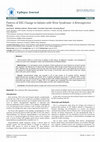
Epilepsy Journal, 2018
West syndrome (WS) is a severe form of epilepsy of early infancy. Its diagnosis, evaluation, and ... more West syndrome (WS) is a severe form of epilepsy of early infancy. Its diagnosis, evaluation, and management continue to pose many challenges to health care professionals and affected families. Methodology: It is a retrospective review of patients of West syndrome who were followed up at least 6 months after diagnosis. We followed up 70 infants with West syndrome. EEG change of each follow up was recorded. For each individual child, we selected minimum three visits in the follow up period. Visit 1 was defined as the visit when the treatment for infantile spasms was started. Visit 2 at day 14 of first visit, Visit 3 at 6 month of first visit. Clinical data on file were used for analysis. Results: Hypsarrhythmia initially was recorded in 20 of total number of 70 patients (28.6%). Modified hypsarrhythmia was recorded in 40 infants (57%), multifocal discharges were found in 7 patients (10%). In third follow up at 6 month, first EEG showed a change of pattern with multifocal discharges in most of the cases (52.9%) while EEG was normal in 24.3% of cases. 30% of our patients were completely free from clinical seizures at 6 months with 67% of them having normal EEG pattern and 29% with multifocal discharges. Conclusion: Interictal EEG pattern changes with clinical course and with treatment.
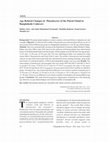
Journal of Bangladesh Society of Physiologist, 2016
Background: The pineal gland (epiphysis cerebri) contains cords and follicles of pinealocytes and... more Background: The pineal gland (epiphysis cerebri) contains cords and follicles of pinealocytes and neuroglia.Objective: To determine the number of the pinealocytes and neuroglial cells per sq. mm of microscopic field in different age group in a Bangladeshi population to view the age related change.Methods: This cross-sectional study was done in the Department of Anatomy, Dhaka Medical College, Dhaka, from July 2009 to June 2010, based on the collection of 60 pineal glands from whole human brains of unclaimed dead bodies from the morgue. All the samples were divided into four age-groups: 15-30 years, 31-40 years, 41-50 years and >50 years. Histological slides were prepared by using routine Harris Haematoxylin and Eosin (H & E) stain. The number of pinealocytes and neuroglial cells per sq. mm of the microscopic field were determined by point counting technique, using ocular micrometer. For statistical analysis, ANOVA and independent sample t test were used.Results: The mean number ...
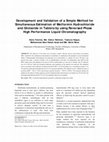
Dhaka University Journal of Pharmaceutical Sciences, 2011
The objective of this study was to develop a simple, efficient, precise and accurate reverse-phas... more The objective of this study was to develop a simple, efficient, precise and accurate reverse-phase HPLC method for the simultaneous determination of metformin in combination with gliclazide in newly formulated tablets. Chromatographic determination was performed on a reversed phase C18 column (2.6 mm x 250 mm; 5 μm particle size) using a mixture of buffer (1 ml of orthophosphoric acid with 1 ml triethylamine upto 1000 ml with HPLC grade water) and methanol at the ratio of 60:40 as mobile phase at a flow rate of 1ml/min. The UV detection was set at 230 nm. Under the developed conditions, good separation of the analytes was achieved. The calibration curves were linear with coefficient correlation between 0.998 to 1.0 for both drugs over a concentration range of 1 to 50 μg/ml for metformin hydrochloride and 0.16 to 8 μg/ml for gliclazide. The method was also validated in terms of precision (RSD = 0.06 to 3.22%) and accuracy (percent deviation = 0.049 to 2.602%). The proposed method was...
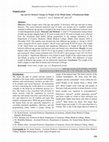
Bangladesh Journal of Medical Science, 2014
Objective: Brain weight varies with age and gender. It decreases with age and also in many diseas... more Objective: Brain weight varies with age and gender. It decreases with age and also in many diseases. This cross-sectional analytical type of study was carried out to establish normal standard in different age groups in weight of the brain and to see the difference between sexes of adult Bangladeshi people. Materials and Methods: A total of 70 postmortem human brains of adult age groups ranging from 22-58 years in male and 22-48 years in female were collected from the unclaimed dead bodies during postmortem at the autopsy laboratory in the Department of Forensic Medicine, Dhaka Medical College, Dhaka, from January 2010 to December 2010. The samples were divided into four different age groups i.e. Group A (20-29 years), Group B (30-39 years), Group C (40-49 years) and Group D (50-59 years). The weight of the whole brain was measured and significant differences in weight of the whole brain between different age groups and between male and female were determined.Results: In male highest...
Bangladesh Journal of Child Health, 2013
Uploads
Papers by Prof. Kanij Fatema